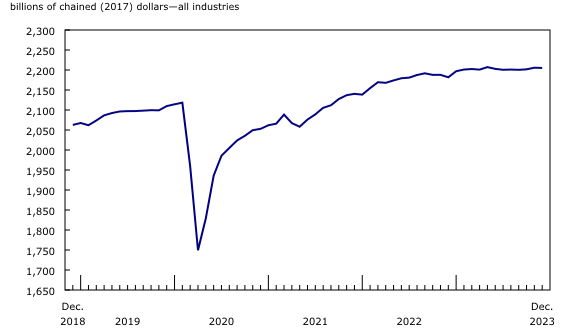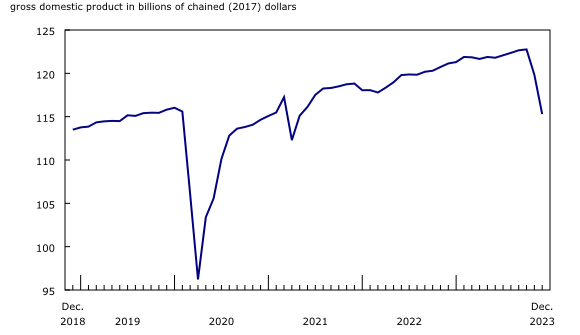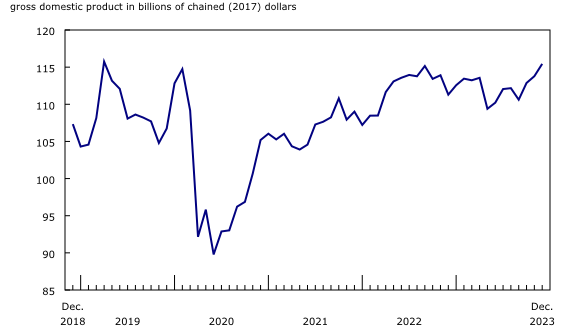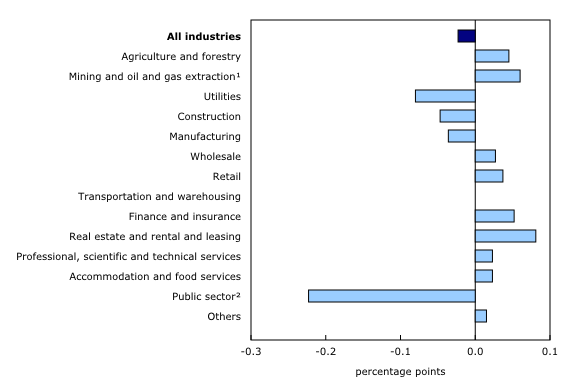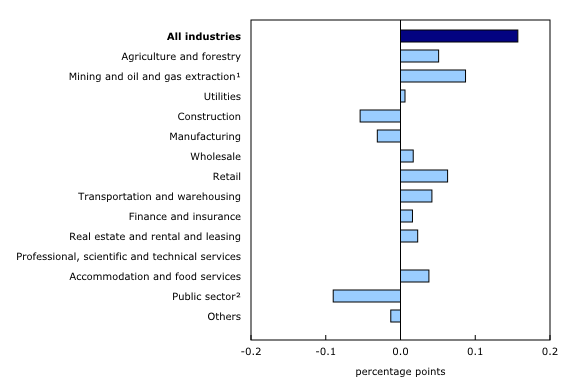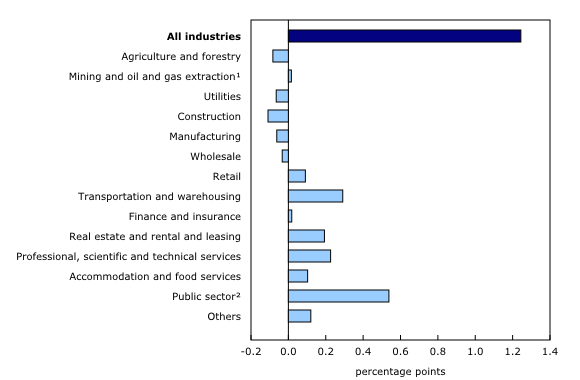Gross domestic product by industry, December 2023
Released: 2024-02-29
December 2023
-0.0% 
(monthly change)
Real gross domestic product (GDP) was essentially unchanged in December, following two months of growth, despite 14 of 20 sectors increasing in the month. Goods-producing industries contracted 0.2% in the month with the utilities, construction and manufacturing sectors accounting for all of the decline in this industries grouping. Meanwhile, services-producing industries were largely unchanged in December as growth across most sectors was offset by declines in educational services and healthcare and social assistance.
Quebec public sector workers' strike weighs on growth
The public sector (consisting of educational services, health care and social assistance, and public administration) declined 1.0% in December for its first back-to-back monthly declines since the onset of the COVID-19 pandemic in March and April 2020.
The educational services sector (-3.8%) was the main detractor to growth in December 2023, impacted heavily by the public sector workers' strike in Quebec that began in November and lasted until the end of December. The strike had the greatest impact on the elementary and secondary schools industry, which contracted 6.1%. This was the largest monthly decrease since April 2021 (-7.3%) when the government of Ontario decided to move the annual March break in the province from March to April for public health reasons.
The health care and social assistance sector contracted 0.2% in December 2023, due to a decline in the hospitals subsector, which was also impacted by Quebec's public sector workers' strike.
Utilities contract in December
The utilities sector (-3.6%) contracted in December as all three industries posted declines.
The electric power generation, transmission, and distribution industry (-3.7%) contributed the most to the decrease, as demand for heating-related purposes dropped due to unseasonably warm weather in December and lower reservoir levels resulting from drought conditions continued to impact hydroelectric power generation.
Natural gas distribution (-5.6%) was also down in December, particularly due to residential and commercial customers.
Construction continues to decline
The construction sector declined 0.6% in December, driven by lower activity in three of four subsectors. Residential building construction (-1.6%) contributed the most to the decline with a second consecutive monthly contraction as all types of residential building construction activities were down in the month. Engineering and other construction activities (-0.7%) and repair construction (-0.1%) also contributed to the decline.
Manufacturing declines as most subsectors contract in December
The manufacturing sector contracted 0.4% in December, partially offsetting the gain recorded in November, with both non-durable goods manufacturing and durable goods manufacturing contributing to the decline.
The transportation equipment manufacturing subsector (-3.1%) was the largest contributor to the decline in December, recording its largest monthly decrease since September 2021, due to production slowdowns for retooling in multiple Ontario assembly plants. Plastics and rubber products manufacturing (-4.2%) was another large contributor to the decline, largely driven by weaker activity in plastic product manufacturing in the month.
The chemical manufacturing subsector (+1.3%) tempered the decline in the sector as activity expanded for a third month in a row in December 2023, following maintenance-related shutdowns in the third quarter.
Mining, quarrying and oil and gas extraction continues to grow
Mining, quarrying and oil and gas extraction grew 1.5%, up for a third consecutive month, as two of three subsectors rose in December.
The oil and gas extraction subsector (+2.4%) led the growth as crude oil production reached a new record high level in December, with facilities continuing to ramp up production following maintenance and turnarounds in the summer and early fall.
Oil sands extraction rose 3.5% in December, following a 4.0% increase in November as crude bitumen extraction and synthetic oil production in Alberta led the growth for a second consecutive month.
Oil and gas extraction (except oil sands) rose 1.3% as both crude oil and natural gas extractions were up in December, buoyed by an increase across Alberta's oil and gas fields and an increase in oil production in Canada's North Atlantic coast as the Terra Nova floating production storage and offloading vessel safely restarted production in late November.
The finance and insurance sector expands as market sentiment rises
Finance and insurance increased 0.8% in December, following a 0.2% decline in November, as a majority of subsectors increased. The financial investment services, funds, and other financial vehicles subsector (+3.2%) drove the gain in the sector. Market sentiment rose and buying activity on the Toronto Stock Exchange increased following the US Federal Reserve interest rate announcement in December, signalling a pause on interest rate hikes and the possibility of cuts coming in 2024.
Real estate and rental and leasing grew 0.6% in December 2023 as increased activity at the offices of real estate agents and brokers (+9.1%) drove the gain. The subsector, which had contracted for five consecutive months prior to December, saw its largest gain since April 2023 as resale activity picked up in the month.
Retail trade grows for a fourth month in a row
Retail trade grew 0.7% in December, up for a fourth consecutive month, with higher retailing activity recorded in 7 of 12 subsectors in the month. General merchandise stores (+3.1%) and food and beverage stores (+1.8%) were the largest contributors to growth in December. Motor vehicle and parts dealers (+1.2%) was one of the largest contributors to growth in December and a driver behind the sector's gains in the previous three months.
Wholesale trade increases for second consecutive month
Wholesale trade was up 0.5% in December, with five of nine subsectors growing in the month. Personal and household goods wholesalers (+4.0%) contributed the most to the sector's increase for a second month in a row, as a jump in pharmaceuticals wholesaling in December coincided with the largest monthly import of pharmaceutical and medicinal products since February 2023.
Advance estimate for real gross domestic product by industry for January 2024
Advance information indicates that real GDP rose 0.4% in January. Increases in educational services and health care and social assistance, resulting from a rebound in activity following the conclusion of the strikes in Quebec in December, were partially offset by decreases in mining, quarrying, and oil and gas extraction and transportation and warehousing. Owing to its preliminary nature, this estimate will be updated on March 28, 2024, with the release of the official GDP by industry data for January.
Real gross domestic product by industry expands in the final quarter of 2023
Real GDP by industry rose 0.2% in the fourth quarter of 2023, after edging down in the previous quarter. Goods-producing industries increased 0.2%, following two consecutive quarterly declines. Services-producing industries edged up 0.1%, growing for the 10th consecutive quarter. Overall, 13 of 20 industrial sectors were up in the final quarter of 2023.
Mining, quarrying, and oil and gas extraction (+2.2%) was the largest driver of growth in the fourth quarter. Oil and gas extraction (+1.9%) was the largest positive contributor to the sector for a third quarter in a row, even as maintenance activity impacted the subsector in the second and third quarters. The mining and quarrying (except oil and gas) subsector rose 4.5% in the fourth quarter, with gains across most industries.
After edging down in the third quarter, retail trade (+1.2%) was the largest contributor to growth in the services-producing industries grouping in the fourth quarter. Health and personal care retailers (+3.8%) drove the retail trade sector's growth, rising for a fourth consecutive quarter. Motor vehicle and parts dealers (+2.7%) further contributed to the growth in the sector in the fourth quarter, posting a second consecutive quarterly increase, as activity at new car dealerships continued to expand.
The public sector (consisting of educational services, health care and social assistance, and public administration) was the largest detractor to growth in the fourth quarter. Educational services (-2.5%) declined, as strikes by Quebec's public sector workers that began in November, continued into December. Elementary and secondary schools were the largest contributor to the decrease in the sector.
The construction sector contracted for the fourth consecutive quarter, down 0.7% in the last quarter of 2023, led by the engineering and other construction activities subsector (-3.8%). An increase in residential building construction (+1.3%) tempered the decline in the sector, as all types of residential building construction activities grew in the final quarter of the year. Non-residential building construction (+1.6%) also expanded as both industrial and public building construction posted gains.
The manufacturing sector was down 0.3% in the fourth quarter, with the transportation equipment manufacturing subsector (-4.4%) contributing the most to the decline. Activity in the subsector fell for the first time in five quarters, driven by declines in the motor vehicle and parts manufacturing industry, as several assembly plants underwent a slowdown in production for retooling activities during the fourth quarter.
Growth slows in 2023
Real GDP by industry increased 1.2% in 2023, its slowest growth rate since 2016 aside from the contraction recorded in 2020. Despite strong growth in the first quarter of 2023, several factors including higher interest rates, inflation, forest fires and drought conditions as well as strikes weighed on overall economic growth in the year. Value added in services-producing industries (+2.1%) continued to expand in 2023, although at the slowest pace in three years. The public sector, transportation and warehousing and professional, scientific and technical services drove the gain. Goods-producing industries contracted (-1.2%), as almost all sectors within this grouping posted declines. The mining, quarrying, and oil and gas extraction sector (+0.4%) was the exception, with an increase in 2023 driven by both the oil and gas extraction and the mining (except oil and gas extraction) subsectors.
The public sector and certain client-facing industries continue to be among the largest contributors to growth in 2023
The public sector (consisting of educational services, health care and social assistance, and public administration) grew 2.5% in 2023 and contributed the most to the increase in services-producing industries, as all components posted gains. Public administration was the largest contributor to growth, driven largely by gains in local, municipal and regional public administration and provincial and territorial public administration. Educational services expanded despite the impact of the public sector strike in Quebec, although it was the sector's slowest growth rate since the contraction in 2020.
Client-facing industries also contributed to growth in 2023. The accommodation and food services sector grew 5.6% as both the food services and drinking places subsector and the traveller accommodation subsector expanded, although at their slowest pace in three years. Activity in accommodation and food services was up in 2023, but still around 9% below its 2019 level. The arts, entertainment and recreation sector continued its recovery from the significant decline observed in 2020, growing 12.9% in 2023, with performing arts, spectator sports and related industries, and heritage institutions contributing the most to the increase.
Air transportation (+28.6%) recorded a second consecutive annual increase in 2023 as travel activity continued to grow. Urban transit systems rose 24.2% in 2023, as more public transit users returned to in-person work during the year. Despite air transportation and urban transit systems posting their second consecutive annual gains, activity for both in 2023 was still below 2019 levels.
Goods-producing industries tempering overall growth in 2023
Several goods-producing industries were down in 2023. The construction sector (-1.5%) was the largest detractor to growth, contracting for the first time since 2020. While engineering and other construction activities and non-residential building construction drove the decline in the sector in 2020, residential building construction was the largest detractor to growth in the construction sector in 2023, falling for a second consecutive year. The downward trend in residential building construction that began in April 2022 continued throughout the first half of 2023, and the gains observed in the second half of the year only partially offset those declines. Meanwhile, activity at the offices of real estate agents and brokers, which saw a strong decline in 2022, continued to contract in 2023, despite gains in the first half of the year, as home sales fell across the country for the second year in a row.
The agriculture, forestry, fishing and hunting sector (-4.5%) was another large detractor to growth in 2023, in large part due to severe drought conditions affecting several crop-producing areas in the country. Support activities for agriculture and forestry (+2.9%) was the only subsector to post a gain, buoyed by support activities for forestry and increased efforts to address the wildfires and their impact.
The manufacturing sector contracted 0.6% in 2023, recording its first decline since 2020. The plastics and rubber products manufacturing subsector was the largest contributor to the decrease in 2023, down 11.6%. After large gains in 2021 and 2022, the plastic products manufacturing industry posted its steepest annual decline since 2009. Computer and electronic product manufacturing (-8.8%) was another large contributor to the decline in the manufacturing sector in 2023, with the communication equipment manufacturing industry leading the decrease. The motor vehicle and parts manufacturing industry (+19.6%), which posted a second consecutive annual gain, tempered the decline in the manufacturing sector in 2023.
Utilities (-2.9%) contracted in 2023 due largely to decreases in electric power generation, transmission and distribution as severe drought conditions in 2023 impacted reservoir levels for hydroelectric generation.
Did you know we have a mobile app?
Get timely access to data right at your fingertips by downloading the StatsCAN app, available for free on the App Store and on Google Play.
Sustainable development goals
On January 1, 2016, the world officially began implementing the 2030 Agenda for Sustainable Development—the United Nations' transformative plan of action that addresses urgent global challenges over the following 15 years. The plan is based on 17 specific sustainable development goals.
The release on gross domestic product by industry is an example of how Statistics Canada supports monitoring the progress of global sustainable development goals. This release will be used to help measure the following goal:

Note to readers
Monthly data on gross domestic product (GDP) by industry at basic prices are chained volume estimates with 2017 as the reference year. This means that the data for each industry and each aggregate are obtained from a chained volume index multiplied by the industry's value added in 2017. The monthly data are benchmarked to annually chained Fisher volume indexes of GDP obtained from the constant-price supply and use tables (SUT) up to the latest SUT year (2020).
For the period starting in January 2021, data are derived by chaining a fixed-weight Laspeyres volume index to the prior period. The fixed weights are 2020 industry prices.
This approach makes the monthly GDP by industry data more comparable with expenditure-based GDP data, which are chained quarterly.
All data in this release are seasonally adjusted. For information on seasonal adjustment, see Seasonally adjusted data – Frequently asked questions.
An advance estimate of industrial production for January 2024 is available upon request.
For more information on GDP, see the video "What is Gross Domestic Product (GDP)?"
Revisions
Each month, newly available administrative and survey data from various industries in the economy are integrated, resulting in statistical revisions. Updated and revised administrative data (including taxation statistics), new information provided by respondents to industry surveys, and standard changes to seasonal adjustment calculations are incorporated with each release.
With this release of monthly GDP by industry, revisions have been made back to January 2023.
The December advance estimate presented in the previous release was updated in the current reference month. More recent information to estimate the impact of the Quebec public sector strike as well as revised data for the manufacturing sector and the electricity generation, transmission and distribution industry contributed the most to the estimate update.
To satisfy the opposing goals for both timeliness and accuracy, Statistics Canada regularly updates (revises) its estimates of GDP. For more information about GDP revisions cycles, please consult the Revisions to Canada's GDP article in the Latest Developments in the Canadian Economic Accounts (13-605-X).
Real-time table
Real-time table 36-10-0491-01 will be updated on March 11, 2024.
Next release
Data on GDP by industry for January 2024 will be released on March 28.
Products
The User Guide: Canadian System of Macroeconomic Accounts (13-606-G) is available.
The Methodological Guide: Canadian System of Macroeconomic Accounts (13-607-X) is also available.
The Economic accounts statistics portal, accessible from the Subjects module of the Statistics Canada website, features an up-to-date portrait of national and provincial economies and their structure.
Contact information
For more information, or to enquire about the concepts, methods or data quality of this release, contact us (toll-free 1-800-263-1136; 514-283-8300; infostats@statcan.gc.ca) or Media Relations (statcan.mediahotline-ligneinfomedias.statcan@statcan.gc.ca).
- Date modified:

